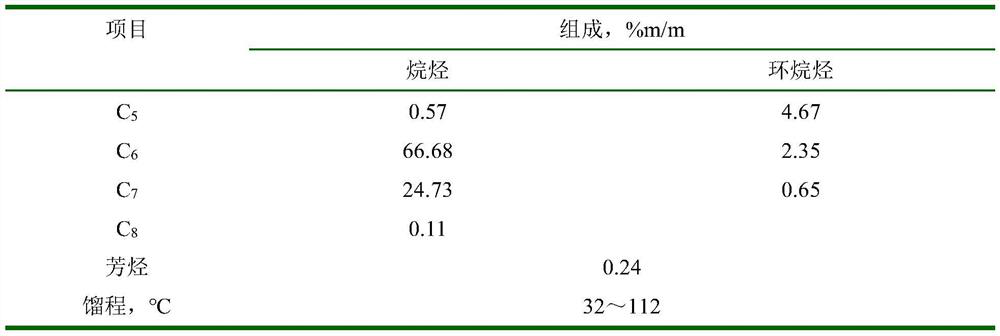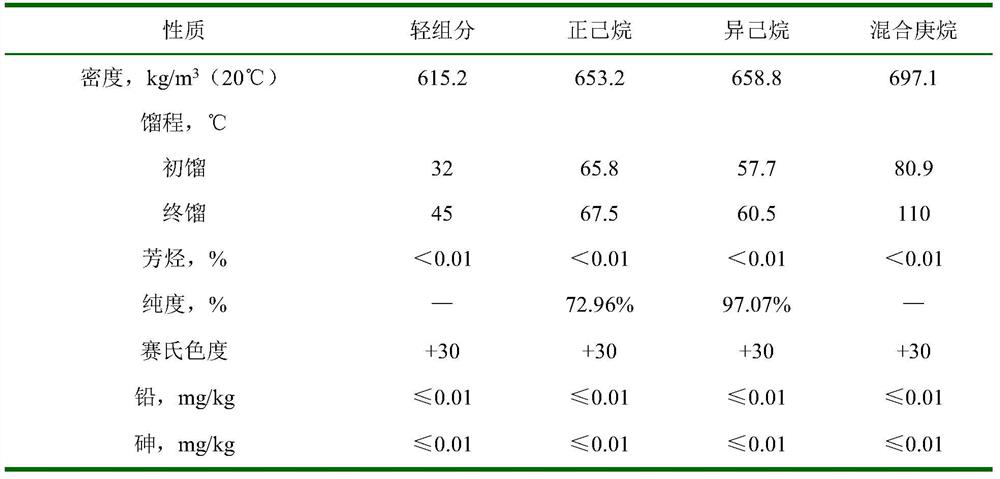Method for producing n-hexane containing heptane raw material
A production method and technology of n-hexane, which are applied in chemical instruments and methods, purification/separation of hydrocarbons, metal/metal oxide/metal hydroxide catalysts, etc., can solve the problem that it is difficult to obtain high-purity isohexane and n-hexane products. , increase the processing load of n-hexane raw materials, it is difficult to meet the requirements of process indicators, etc., to achieve good stability and regeneration performance, long-term operation, and flexible adjustment.
- Summary
- Abstract
- Description
- Claims
- Application Information
AI Technical Summary
Problems solved by technology
Method used
Image
Examples
Embodiment 1
[0024] The properties of raw materials are shown in Table 1.
[0025] Table 1 Raw material properties 1
[0026]
[0027] A kind of n-hexane production method that contains heptane raw material, it comprises the following steps:
[0028] Step 1. After the raw material is mixed with hydrogen and exchanged heat with the reaction product, the temperature is 142°C. After being heated by a heater to 172°C, it enters the reactor to contact with the catalyst, and the hydrofining reaction is carried out under the action of the hydrofining catalyst. The catalyst is Ni-based catalyst, the appearance is spherical, and the specific surface area of the catalyst is 50-90m 2 / g, pore volume: 0.15~0.3ml / g, bulk specific gravity: 0.6±0.02g / ml, radial compressive strength: 24~38N / grain.
[0029] Step 2, the reaction product enters the deheptanizer for pre-fractionation after gas-liquid separation in the low-pressure separator, and most of the heptane in the reaction product is separated,...
Embodiment 2
[0038] See Table 4 for raw materials.
[0039] Table 4 raw material crude hexane properties 2
[0040]
[0041] A kind of n-hexane production method that contains heptane raw material, it comprises the following steps:
[0042] Step 1. After mixing the raw material with hydrogen and exchanging heat with the reaction product, the temperature is 136°C, heated to 178°C by the heater, entering the reactor to contact with the catalyst, and the hydrofining reaction is carried out under the action of the hydrofining catalyst. The catalyst is Ni-based catalyst, the appearance is spherical, and the specific surface area of the catalyst is 50-90m 2 / g, pore volume: 0.15~0.3ml / g, bulk specific gravity: 0.6±0.02g / ml, radial compressive strength: 24~38N / grain. .
[0043] Step 2, the reaction product enters the deheptanizer for pre-fractionation after gas-liquid separation in the low-pressure separator, and most of the heptane in the reaction product is separated, and then the obtai...
PUM
| Property | Measurement | Unit |
|---|---|---|
| density | aaaaa | aaaaa |
| specific surface area | aaaaa | aaaaa |
| specific surface area | aaaaa | aaaaa |
Abstract
Description
Claims
Application Information
 Login to View More
Login to View More - R&D
- Intellectual Property
- Life Sciences
- Materials
- Tech Scout
- Unparalleled Data Quality
- Higher Quality Content
- 60% Fewer Hallucinations
Browse by: Latest US Patents, China's latest patents, Technical Efficacy Thesaurus, Application Domain, Technology Topic, Popular Technical Reports.
© 2025 PatSnap. All rights reserved.Legal|Privacy policy|Modern Slavery Act Transparency Statement|Sitemap|About US| Contact US: help@patsnap.com



